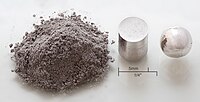
Photo from wikipedia
Abstract A new family of cyclometalated palladium(II) complexes with the non-symmetric dimeric liquid crystal Schiff base α-(4-cyanobiphenyl-4′-yloxy)-ω-(4-n-decyloxyanilinebenzylidene-4′-oxy) hexane and alkoxysubstituted N-benzoyl thiourea (BTU) derivatives as auxiliary ligands was designed and… Click to show full abstract
Abstract A new family of cyclometalated palladium(II) complexes with the non-symmetric dimeric liquid crystal Schiff base α-(4-cyanobiphenyl-4′-yloxy)-ω-(4-n-decyloxyanilinebenzylidene-4′-oxy) hexane and alkoxysubstituted N-benzoyl thiourea (BTU) derivatives as auxiliary ligands was designed and prepared with the aim to study the influence of increasing the number of aliphatic chains on the molecular organization in the liquid crystal phase. The liquid crystalline behavior of these palladium(II) complexes was investigated by a combination of polarized optical microscopy (POM), differential scanning calorimetry (DSC) and powder X-ray diffraction. A transition from the lamellar (complex 3a with two aliphatic chains on BTU ligand) to columnar organization (complexes 3b and 3c having three and four chains on BTU ligand, respectively) was evidenced for these palladium(II) complexes, which was correlated with the increase of the number of terminal chains at molecular periphery.
Journal Title: Journal of Molecular Liquids
Year Published: 2017
Link to full text (if available)
Share on Social Media: Sign Up to like & get
recommendations!